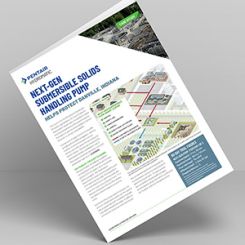Correctly sizing the equipment is crucial for optimum performance.
11/22/2013
Although selecting high-efficiency pumps for irrigation applications is important, pump sizing is equally critical to reduce energy consumption and costs. In fact, incorrect sizing is a common reason for low pumping efficiency. Optimal pump selection requires choosing the product that is best suited to the operating conditions required by the irrigation application. To ascertain whether the operating conditions are stable, users must calculate how much pump flow and head are required.
Calculating Flow
End users should determine the amount of water to be applied during the peak period by multiplying the size of the field by the amount of water in inches that must be applied. The result is then converted to gallons per minute (gpm), and this number determines the size of the pump. For example, to grow corn on a 50-acre field using water from a well, a pump with best efficiency at 524 gpm could pump for 24 hours per day. However, to allow for system downtime and power cost windows, a larger pump will always be chosen, and a runtime of between 12 and 18 hours per day is typical. Figure 1. Efficiency curves for a submersible pump—The pump’s nameplate typically notes the pump’s flow at its best efficiency. Another number typically refers to the number of bowls and how much pressure the pump can produce.
Figure 1. Efficiency curves for a submersible pump—The pump’s nameplate typically notes the pump’s flow at its best efficiency. Another number typically refers to the number of bowls and how much pressure the pump can produce.Calculating Head
An irrigation pump has to overcome the following four elements of pressure:- Pressure required for the application devices (such as sprinklers, spray heads and drippers)
- Friction loss from the piping system, pipes, screens, valves, elbows and tees
- Elevation lift
- Suction lift
 Figure 2. Pressure elements
Figure 2. Pressure elements Figure 3. Typical submersible pump installation
Figure 3. Typical submersible pump installation- There is no suction lift.
- The drawdown has to be added to the elevation lift.
- The application device uses 10 psi of pressure, or 23 feet of head.
- The friction loss in the pipes, elbows, valves and tees has been calculated to 30 psi, or 69 feet of head.
- Assume that the elevation lift is only 58 feet of head.
- The static water level is 200 feet (this corresponds to suction lift for a surface pump).
- The drawdown in the well is 10 feet.
 Figure 4. Data curve for a three-stage pump
Figure 4. Data curve for a three-stage pumpGroundwater Wells
A well is an opening that stretches from the surface of the ground to an underground aquifer, where the groundwater is located. The depth of the well may vary from a few meters to several hundred meters. Wells are typically drilled with special drilling equipment that can penetrate the ground’s layers—such as sand, clay and bedrock. Inside the drilled hole, a casing (pipe) is typically installed, which prevents the well from collapsing around the pump. Below the casing and in line with the aquifer is another casing with fine slots. This is the well screen, where the slots allow the water to enter the well. It prevents sand and larger particles from entering the well. To improve the filtering function, the borehole typically features a diameter that is 2 to 3 inches larger than the casing. A fine sand gravel pack filter is placed between the casing and the aquifer (see Figure 5). Some casings come with a pre-made gravel pack filter. If made correctly, this filtering method prevents sand and silt from entering the well. Figure 5. A submersible pump in a groundwater well installation
Figure 5. A submersible pump in a groundwater well installation- 1 part per million (ppm) in water for drip and microspray applications
- 10 ppm in water for sprinkler irrigation systems
- 15 ppm in water for flood irrigation

